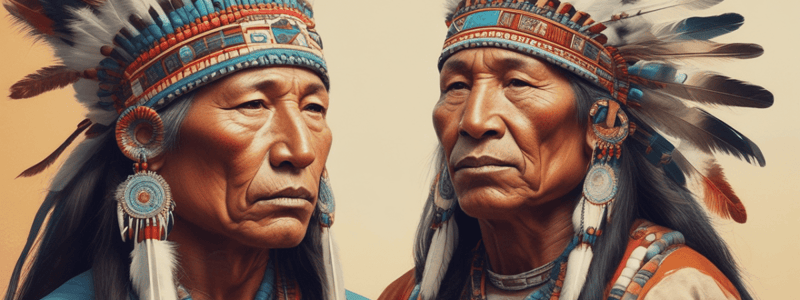Podcast
Questions and Answers
What is the primary purpose of the Indian Self-determination and Education Assistance Act of 1975?
What is the primary purpose of the Indian Self-determination and Education Assistance Act of 1975?
- To reinforce the concept of blood quantum for tribal membership
- To abolish reservations and consolidate tribes
- To limit the tribal rights of federally recognized tribes
- To give federally recognized tribes authority over their membership criteria (correct)
Who has the authority to determine tribal membership for the disbursement of federal program funds?
Who has the authority to determine tribal membership for the disbursement of federal program funds?
- Congress
- Individual tribes themselves
- State governments
- Federal agencies (correct)
Which concept, mentioned in the text, is used as a criterion to receive certain services like Indian housing and health care?
Which concept, mentioned in the text, is used as a criterion to receive certain services like Indian housing and health care?
- Indigenous community affiliation
- Blood quantum (correct)
- Lineal descent
- Racialization
What did the “Report on Indians Taxed and Not Taxed” suggest in relation to reservations and tribes?
What did the “Report on Indians Taxed and Not Taxed” suggest in relation to reservations and tribes?
Which entity retains the power to deny or revoke acknowledgment of any tribe and its members despite tribes setting their own membership criteria?
Which entity retains the power to deny or revoke acknowledgment of any tribe and its members despite tribes setting their own membership criteria?
What is the purpose of a Certificate of Degree of Indian Blood (CDIB) card?
What is the purpose of a Certificate of Degree of Indian Blood (CDIB) card?
Why does the United States insist that tribal members must have 'some Indian blood'?
Why does the United States insist that tribal members must have 'some Indian blood'?
Which Act granted federally recognized tribes the authority to establish their own membership criteria?
Which Act granted federally recognized tribes the authority to establish their own membership criteria?
'Racialization' as described in the text refers to:
'Racialization' as described in the text refers to:
'Plenary power' granted to Congress, as discussed in the text, allows it to:
'Plenary power' granted to Congress, as discussed in the text, allows it to:
What was the primary reason the researcher used purposive sampling to select participants?
What was the primary reason the researcher used purposive sampling to select participants?
Which of the following best describes the researcher's approach to indigenous epistemology?
Which of the following best describes the researcher's approach to indigenous epistemology?
What was the primary purpose of the researcher's use of a blended critical and indigenous interpretive lens?
What was the primary purpose of the researcher's use of a blended critical and indigenous interpretive lens?
What was the primary reason the researcher used a blended approach for data analysis?
What was the primary reason the researcher used a blended approach for data analysis?
Which perspective does the passage suggest is problematic for determining authentic Indigeneity?
Which perspective does the passage suggest is problematic for determining authentic Indigeneity?
What does the passage suggest is the significance of blood and ancestry in Indigenous conceptions of identity?
What does the passage suggest is the significance of blood and ancestry in Indigenous conceptions of identity?
According to the passage, what is the primary concern with using racial or cultural boundaries to determine group membership in Indigenous communities?
According to the passage, what is the primary concern with using racial or cultural boundaries to determine group membership in Indigenous communities?
What does the passage suggest is a promising approach to honoring the survival, resistance, and resilience of Indigenous ancestors?
What does the passage suggest is a promising approach to honoring the survival, resistance, and resilience of Indigenous ancestors?
What does the passage suggest is the significance of self-representation and boundaries of belonging for Indigenous communities?
What does the passage suggest is the significance of self-representation and boundaries of belonging for Indigenous communities?
According to the passage, what is the primary concern with using Indian cards as proxies for cultural belonging and protection of resources?
According to the passage, what is the primary concern with using Indian cards as proxies for cultural belonging and protection of resources?
What does the passage suggest is the role of blood and ancestry in the development of contemporary American Indian identity?
What does the passage suggest is the role of blood and ancestry in the development of contemporary American Indian identity?
According to the passage, what is the significance of the peoplehood matrix in relation to Indigenous identity and belonging?
According to the passage, what is the significance of the peoplehood matrix in relation to Indigenous identity and belonging?
Flashcards are hidden until you start studying




